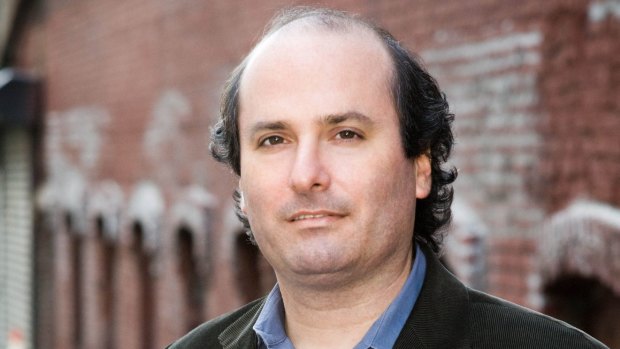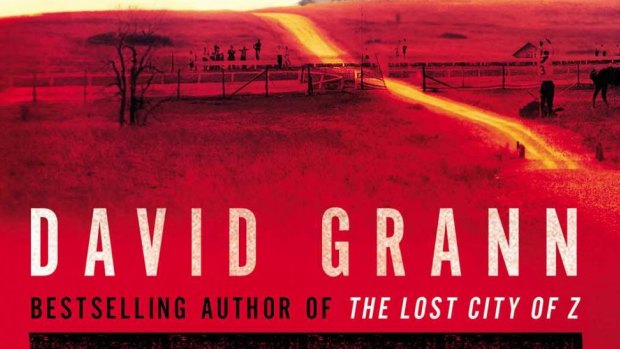By Jason Steger
Truth is a fragile concept at the best of times, but in the US these days it seems particularly so. Perhaps it has ever been so.
David Grann has a sharp sense of how it's faring, both through his own investigative journalism for The New Yorker and in his books such as The Lost City of Z and, most recently, Killers of the Flower Moon.

Author David Grann.
"One of the things I believe strongly in is developing institutions – legal, press, bureaucracies, academies – that are rooted in the pursuit of impartial truth. That aren't simply just bent to partisan ends or are corrupted for the powerful or for other ulterior motives."
Killers of the Flower Moon is Grann's account of an investigation into the murders of a vast number of the Osage people of Oklahoma. The motive was greed; the methods included poison, arson, bullets; the conspiracy widespread, and the outcome a trauma for these Native Americans that survives nearly 100 years later.

Killers of the Flower Moon. By David Grann.
The case was one of the first for the fledgling FBI (then the Bureau of Investigation) under its new director, J. Edgar Hoover.
With the recent tension between the bureau and the Trump administration, Grann says it is easy to take the strength of these institutions for granted. Writing Killers gave him a real sense of their importance and how crucial it is that the US should be a country of laws.
Nearly 100 years ago, the Osage were per head of population the richest people in the world. That's because when they had settled on their part of Oklahoma, they had – almost uniquely – retained headrights to minerals that lay beneath the surface. So when oil was discovered, they accrued the substantial benefits.
But then they started dying. Mollie Burkhart's sister Minnie died from a "peculiar wasting illness" and three years later, in May 1921, another sister, Anna, disappeared. She was found a week or so later, on her back near a creek, so decomposed she was being eaten by worms.
And there were others who died in mysterious ways; others from Mollie's family, and plenty of others from the Osage nation.
A historian told Grann about the murders and eventually he went to Oklahoma and visited the Osage museum. There he saw a panoramic photograph of the Osage taken in 1924, but he noticed something odd about it: a portion was missing and it looked as it had been cut out.
He asked the director what had happened. When she retrieved an image of the missing panel from the basement, it turned out to contain William Hale, one of the masterminds of the killings of the Osage.
"The book really grew out of trying to understand who that figure was and that anguish in history that he embodied," Grann says. "The thing that really struck me was the director and the Osage people had removed that not to forget but because they can't forget.
"So many people, including myself, had no knowledge and no memory of these crimes that were really a microcosm of so many forces playing out in this country – from law enforcement, the clash of native Americans and white settlers – and really it is a crime that is essential to understanding the formation of the United States."
The book tells the story of those crimes and their investigation and has two people, Mollie Burkhart and bureau agent Tom White, at its heart.
"The crimes were able to go on for years because of a deep-seated prejudice," Grann says. "They often went unsolved because the victims were Native Americans and the breadth of the conspiracy was far wider than the bureau exposed."
So what it boiled down to was that the case was less of who did it, but who didn't do it. "I spend my life mostly disproving conspiracies. Most don't really bear out close inspection, but this is a case of the more you dig, the more you find you are swimming in a conspiracy with multiple conspirators on many levels of society."
Grann is writing about the last days of the old West and Mollie comes across as a remarkable woman, straddling two centuries and in some senses two civilisations. She was born in a wigwam, spoke Osage, followed traditional customs, yet within a few decades was living in a mansion, had married her chauffeur and was speaking English.
"She very quietly crusades for justice all the while putting a bull's eye on her. It took enormous courage. And Tom White, who is fallible, not some superhuman detective, not Sherlock Holmes, has a quiet goodness and he does go about his business at a time of great prejudice and does at least try to pursue justice."
White was born in a log cabin on the Texas frontier, his father was a lawman, he watched criminals hanged when he was a child and became a lawman at a time when justice was often meted out through a barrel of a gun.
"By the time he takes over the Osage murder case, he is wearing a suit, trying to adapt to techniques like fingerprints and handwriting analysis and he has to file paperwork, which he can't stand," Grann says.
"He is part of a corporated rather than communal law. He himself embodies the transformation of the law and the country. So this case thrusts them both together, these two in a way tribal figures, in the formation of the country."
Mollie must have been a remarkable character given that she was marginalised twice – as a woman and as a Native American. So did Grann have any concerns about being a white New Yorker telling the Osage story.
He says he approaches stories about other people and other cultures with judiciousness and sensitivity. "I spent a lot of time with the Osage, time with Mollie's descendants. I went over things with the Osage. I went over my depictions with the leading anthropologists of the Osage who read the books before it was published."
When the book did appear he presented it to the descendants and, in return, received a beautiful, traditional blanket. At a special event there were descendants of the murderers and the victims. "They still live in the same neighbourhoods. Their fates are intertwined and in many ways that's the story of America."
The largest part of Killers of the Flower Moon deals with the historical record and details the murders, the investigation and the eventual trial of some of the perpetrators. It tells an appalling story of exploitation, cold-hearted greed and staggering evil. As one Osage said to Grann: "Who would believe that anyone would marry you and kill your family for your money?"
But as Grann got his head round all the details of the case, it became clear that there were holes in the bureau's investigation, that the conspiracy went so much further and so much wider. He launched his own investigation into several of the murders, which takes up the final chunk of the book, and concludes: "Virtually every element of society was complicit in the murderous system … a vast criminal operation that was reaping millions and millions."
In The Lost City of Z, Grann's search for the lost explorer, Percy Fawcett, he talks about being in what H. Rider Haggard called the grip of a story. He was in the grip with the story of the Osage, he says, more than any story he has worked on.
"There was a sense of the moral importance of this story that weighed on me in a way differently, especially as I got to know so many Osage and many of the descendants – descendants of both the murderers and their victims – and began to try to record their stories and the more I began to get a sense of the breadth of this conspiracy than previously exposed."
Grann wasn't involved in the recent film of The Lost City either on screen or off. Very much a character in the book as he follows in the footsteps of the doomed Fawcett into the Amazon jungle, the film cut him out completely. "They couldn't find anyone good looking enough to play me," he says. But he was happy not to write the script.
There has been interest in making a film based on The Killers and Grann is keen, primarily for the benefit of the Osage. "This is a story about a real racial injustice that has been ignored and neglected and not incorporated into many mainstream history texts. The power of a film to reach people and give a story a life … I wish a book could reach as many people as film, but we have to be realistic about it."
Whether it will, remains to be seen. "The only thing as murky as a conspiracy is what's happening in Hollywood," Grann says.
The Killers of the Flower Moon is published by Simon & Schuster at $32.99. David Grann is a guest at next month's Melbourne Writers Festival (mwf.com.au). He'll appear at a Q&A after a screening of The Lost City of Z at the Hayden Orpheum on August 30.